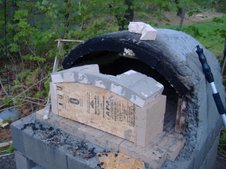These Fox money shows are something else. Do your own math:
180,000 foreclosures in July. The average foreclosure was probably $60,000 in the hole. 180,000 times $60,000 equals somewhere around an $11 billion monthly loss. The housing market wasn’t a story during these foreclosures in July. Housing prices are still dropping while more supply is injected in to the market through foreclosures and demand is drying up through tighter lending. A rational person, $100,000 in the hole on his home, is more likely to walk away today than he was in July.
The Fox trumpeted Bank of America’s $2 billion purchase of Countrywide stock doesn’t mean a thing. The fact that Central Banks just printed $500 billion in money should worry you. That’s what we’ve spent in Iraq. It represents two months worth of our entitlement problems.
Housing prices will be stable in the long run because local governments have raised development costs to the point where more supply cannot be built for less than current market rates. The banks are the ones in trouble.
Saturday, August 25, 2007
Monday, August 20, 2007
Housing Economics
Americans had around $10 trillion dollars in aggregate home equity and around $9 trillion in outstanding mortgage debt on family residences. The aggregate home equity number may have just dropped by a few trillion.
Every real estate market is different, but the one I’m familiar with is probably representative of many. In the late nineties, you could buy a 1200 s.f. house for just under $100,000. At the market peak in early 2005, that 1200 s.f. house sold for ~$240,000. One local project has been steadily lowering prices and is now offering the house at $135,000, and is starting to get traffic.
But something else has changed. The government has learned to make money in the business. Our impact fees in 1997 were less than $5,000 per unit. Impact fees today can be over $40,000 per unit. Between these fees and increases in material costs, there really is no incentive to build new housing today. Those building are just doing it to liquidate inventory.
The good news is that housing values cannot drop much lower in the long term, as new supply cannot be created when there’s no money in building houses. The bad news is that, in the short term, there are three dangers:
1. Millions of Americans now owe more than their house is worth. A percentage of them will walk away from their homes, causing more inventory in a market where demand has tanked because of tightened lending practices. It is possible that this could spiral downward.
2. The bigger threat from a national perspective is the potential failure of banks. Banks have loaned lots and lots of money (see $9 trillion above) to people who had little or no equity at the peak of the market. The bank’s bad loan is now secured with a house that yields them a net loss of $100,000 per loan. Read the Federal Reserve's recent bailouts of banks at the link below. July posted 179,000 foreclosures, leaving lenders with a $200 billion hit for the month.
3. The local governments that have become addicted to builder money will come after you next.
Central Banks have so far ‘released’ (really given IOUs on the taxpayer’s backs) over a half a trillion dollars to keep banks liquid. This could be bad.
http://www.federalreserve.gov/boarddocs/press/monetary/2007/20070817/default.htm
Every real estate market is different, but the one I’m familiar with is probably representative of many. In the late nineties, you could buy a 1200 s.f. house for just under $100,000. At the market peak in early 2005, that 1200 s.f. house sold for ~$240,000. One local project has been steadily lowering prices and is now offering the house at $135,000, and is starting to get traffic.
But something else has changed. The government has learned to make money in the business. Our impact fees in 1997 were less than $5,000 per unit. Impact fees today can be over $40,000 per unit. Between these fees and increases in material costs, there really is no incentive to build new housing today. Those building are just doing it to liquidate inventory.
The good news is that housing values cannot drop much lower in the long term, as new supply cannot be created when there’s no money in building houses. The bad news is that, in the short term, there are three dangers:
1. Millions of Americans now owe more than their house is worth. A percentage of them will walk away from their homes, causing more inventory in a market where demand has tanked because of tightened lending practices. It is possible that this could spiral downward.
2. The bigger threat from a national perspective is the potential failure of banks. Banks have loaned lots and lots of money (see $9 trillion above) to people who had little or no equity at the peak of the market. The bank’s bad loan is now secured with a house that yields them a net loss of $100,000 per loan. Read the Federal Reserve's recent bailouts of banks at the link below. July posted 179,000 foreclosures, leaving lenders with a $200 billion hit for the month.
3. The local governments that have become addicted to builder money will come after you next.
Central Banks have so far ‘released’ (really given IOUs on the taxpayer’s backs) over a half a trillion dollars to keep banks liquid. This could be bad.
http://www.federalreserve.gov/boarddocs/press/monetary/2007/20070817/default.htm
Sunday, August 12, 2007
The NTSB and The System
"We will take our time. Because when we get it, it will be right," said Rosenker. "And when we get it right and provide the probable cause, we'll also be making recommendations to prevent this kind of thing from happening again."
Gusset plates connect the bracing members of steel structures. NTSB Chairman Mark Rosenker said that investigators found a "design issue" with the plates. I’ve contacted the NTSB asking for information on the design issue for my use. So far nothing but chirping crickets.
The steel lying at the bottom of the Mississippi holds all of the answers. The NTSB finger has already been pointed at Progressive Contractors, Inc. for storing a truckload of material on the deck and the dead bridge designer. And nobody knows squat about what happened to that lightly loaded bridge on a quiet Minnesota evening.
So it only makes sense to raise gasoline taxes 5 cents a gallon and distribute $40 billion additional taxpayer dollars to civil servants and government contractors. Because, you know, you can’t be too safe. And it’s all about safety.
Interesting paper on gusset plates:
http://www.aisc.org/Content/ContentGroups/Documents/Steel_Tips1/144_dec_98.pdf
Gusset plates connect the bracing members of steel structures. NTSB Chairman Mark Rosenker said that investigators found a "design issue" with the plates. I’ve contacted the NTSB asking for information on the design issue for my use. So far nothing but chirping crickets.
The steel lying at the bottom of the Mississippi holds all of the answers. The NTSB finger has already been pointed at Progressive Contractors, Inc. for storing a truckload of material on the deck and the dead bridge designer. And nobody knows squat about what happened to that lightly loaded bridge on a quiet Minnesota evening.
So it only makes sense to raise gasoline taxes 5 cents a gallon and distribute $40 billion additional taxpayer dollars to civil servants and government contractors. Because, you know, you can’t be too safe. And it’s all about safety.
Interesting paper on gusset plates:
http://www.aisc.org/Content/ContentGroups/Documents/Steel_Tips1/144_dec_98.pdf
Saturday, August 4, 2007
Condoleezza Rice
Although the group stressed a kind of grand jihad in eliminating and destroying the Western civilization from within, Tom Casey of the State Department stressed that there was no indication of a terrorist connection.
It is absolutely outrageous and reprehensible for anyone to suggest a religious basis for terror, whether the individuals are Muslim, Christian, Jewish or those of any other religion, a clearly agitated Casey told reporters, shaking his head in disgust.
Gonzalez is a discredited idiot and needs to rein in his prosecutors, Casey seethed, this is about hearts and minds, moms and dads. We hope the Justice Department exercises better judgment in the future.
It is absolutely outrageous and reprehensible for anyone to suggest a religious basis for terror, whether the individuals are Muslim, Christian, Jewish or those of any other religion, a clearly agitated Casey told reporters, shaking his head in disgust.
Gonzalez is a discredited idiot and needs to rein in his prosecutors, Casey seethed, this is about hearts and minds, moms and dads. We hope the Justice Department exercises better judgment in the future.
Subscribe to:
Posts (Atom)







